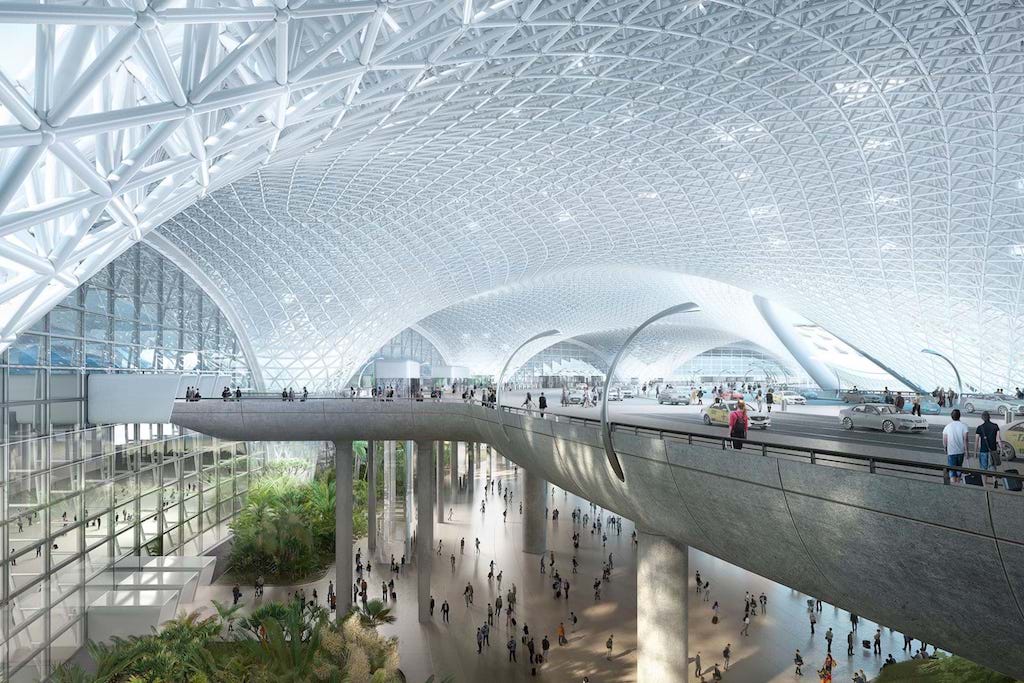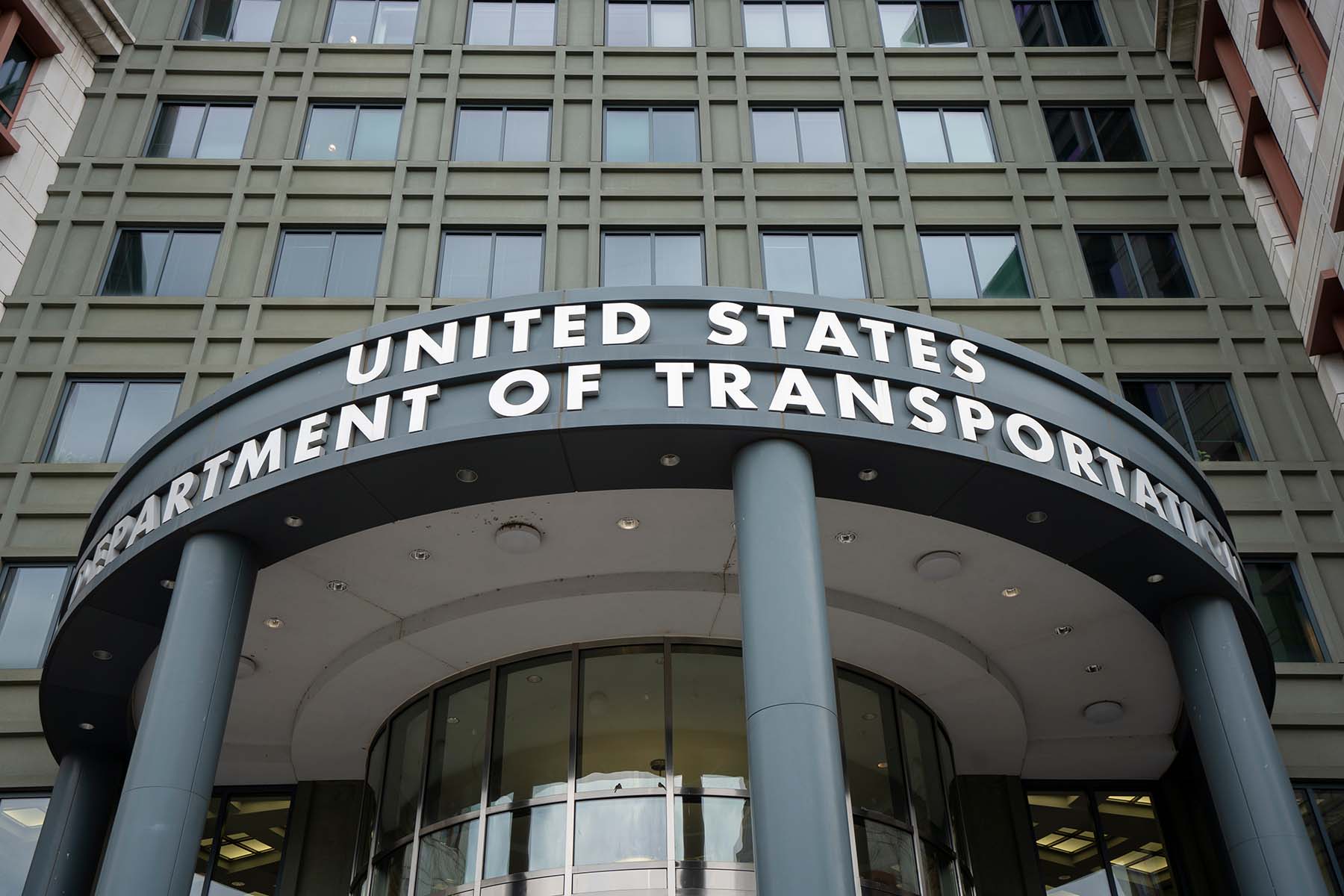Local Politics Threaten to Derail Mexico's New International Airport

Skift Take
One expects to encounter gigantic new airports under construction in East Asia, or along the Persian Gulf. In North America, not so much: Denver International Airport, which opened for business in 1995, is the last big-time, all-new airport to have been built on this continent. Lack of available space near big cities, environmental concerns and political obstacles have all stood in the way of building more. This unwillingness or inability to create new “aerotropolises,” as University of North Carolina business school professor John Kasarda has dubbed the economic hubs that grow up around major airports, risks becoming a competitive disadvantage.
But wait! There is a giant new North American airport in the works. It’s probably not where you’d expect, though.
What is currently being called the Nuevo Aeropuerto Internacional de la Ciudad de México (NAICM for short) is taking shape just outside Mexico City. Construction of the runways is about halfway done, the control tower is now going up, and a terminal designed by architects Norman Foster and Fernando Romero is set to follow. The initial phase, due to open in 2020 although that seems like quite a stretch, will be able to handle 68 million passengers a year, a more than 50 percent increase over Mexico City’s existing Benito Juárez International Airport (which would be shut down when the new airport opens) and roughly equivalent to 2017 traffic at Dallas/Fort Worth International, the continent’s third-busiest airport and the world’s 12th busiest. A planned expansion could bring capacity to 120 million passengers a year, almost 20 million more than went through the world’s busiest airport, Hartsfield-Jackson Atlanta International, in 2017.
There is a complication, though: The runaway front-runner in this year’s Mexican presidential race, Andrés Manuel López Obrador (Amlo for short), has vowed to cancel the project if he is elected.
This has provided ample opportunity for the acronym-happy Mexican news media to run headlines containing both “NAICM” and “AMLO,” which is sort of fun. It has also begun to spark understandable alarm among the Mexican business community, which has both high hopes for the airport project and a big stake in it, with 70 percent of the $13 billion estimated cost being financed by private investors. The country’s richest man, Carlos Slim — who is not only a major investor in and building contractor on the airport but also the father-in-law of architect Romero — held a much-discussed news conference last month to plead the airport’s case. The head of the company overseeing the project estimated in March that cancellation would cost $6.6 billion, while analysts at Moody’s Investors Service and Barclays Plc have warned in recent weeks that it would have broader negative consequences for the Mexican airport sector and the economy as a whole.
So what’s going to happen? Seriously, don’t ask me: I recently spent an educational nine days in Mexico City, but I’m no expert on the country’s politics. More to the point, nobody in Mexico seems to know, either — except perhaps for López Obrador. The former Mexico City mayor’s main stated objections to the airport have been that it is expensive and rife with corruption. It is definitely expensive, although by this point canceling it would be awfully expensive, too, especially with current President Enrique Peña Nieto rushing to get as much completed as possible before leaving office in December. As for corruption, Peña Nieto’s government has certainly had issues with that. On the airport, it has worked with the Organization for Economic Cooperation and Development to structure a comparatively competitive and transparent bidding process, although the outsized role played in Mexico’s economy by family empires such as Slim’s does lend a certain incestuousness to the project.
While López Obrador is usually called a leftist, and he does lean left on most economic matters, he’s also a populist nationalist with tendencies toward fiscal and social conservatism. He “hates grandiosity,” one Mexico City businessman told me. The new airport is a grand, globalist project backed by billionaires, while most of the country’s voters can’t afford to fly. One can see why opposing it appeals to him politically.
Still, even López Obrador acknowledges that Benito Juárez International is at capacity, and he has proposed expanding the Santa Lucía military air base 30 miles (43 kilometers) to the north into a commercial airport, with the idea that it could coexist with Benito Juárez as JFK does with La Guardia in New York. Such two-airport arrangements are less than optimal for airlines and many travelers, though, and as Andrea Navarro of the Bloomberg News Mexico City bureau detailed in an article last week, the flight paths into and out of Benito Juárez and Santa Lucía would overlap and conflict, thus restricting potential traffic.
Mexico City faces unique airspace constraints, it turns out. Also unique is the presence of a vast, flat expanse of government-owned land not far from the center of one of the world’s largest and most crowded metropolises. These two physical realities have played as big a role in shaping the current airport project as the political ones. So as we await the denouement of the election saga, let’s explore them.
First, the airspace constraints: Mexico City is more than 7,000 feet (2,134 meters) above sea level and surrounded by mountains that loom much higher. There’s a 12,894-foot (3,930-meter) dormant volcano within the city limits, and an active 17,689-foot (5,393-meter) one 43 miles (70 kilometers) away. At higher elevations the air is thinner, and aircraft have to fly faster to stay aloft. One thing this means for takeoffs and landings, says Bernard Lisker, international aviation portfolio director at Mitre Corp. and a key source for Navarro’s article, is that the planes have to be spaced farther apart than they would at sea level. So while Benito Juárez International has two runways, they’re too close together to be used simultaneously, given Mexico City’s elevation. And while Santa Lucía and Benito Juárez are farther apart than JFK and La Guardia are, the mountains mean that, in Lisker’s words, “you cannot approach from every direction you want to,” thus restricting available entry flight paths.
Mitre is a nonprofit spun out of the Massachusetts Institute of Technology in 1958 that does research and development work for federal agencies in the U.S. and advises them and governments around the world on, among other things, the safest and most efficient use of airspace. Mitre was first asked to look into possible Mexico City airport locations in the late 1990s, during the administration of President Ernesto Zedillo. The government was considering options that included expanding the current airport and using the Santa Lucía air base — both of which Mitre found impractical for the reasons discussed above — along with several other proposals that involved keeping the existing airport and using a new or expanded airport well outside the city to add capacity. Mitre determined that the best solution, though, was a single, bigger airport located on the aforementioned gigantic tract of flat, undeveloped land northeast of the city.
This land was undeveloped because most of it used to be under the waters of Lake Texcoco. Most of what is now Mexico City used to be underwater, in fact. The Aztecs had built their capital, Tenochtitlan, on an island near Texcoco’s western shore, and after conquering it in 1521, the Spanish made it their capital and soon began expanding its footprint. By the late 1800s, as University of California at San Diego historian Matthew Vitz described it in a 2012 journal article:
The Valley of Mexico ... was a closed basin composed of three major lakes: Texcoco, Chalco, and Xochimilco. Nourished by rainwater from the surrounding mountains, the lakes also silted with eroded soil and salts from volcanic rock. The lowest and largest lake, Texcoco, served as the ultimate container of both the basin’s water and its salts. Although colonial era drainage projects and sedimentation had reduced the size of these lakes, Lake Texcoco could extend to over 27,000 hectares during the rainy season.
How big is 27,000 hectares? It’s 104 square miles, or more than four Manhattans. After 1900, when the government of longtime President Porfirio Díaz completed the Grand Drainage Canal (Gran Canal del Desagüe), more and more of those hectares began to stay dry year-round. Excessive groundwater pumping caused the city to sink, too, which, combined with the silting described above, eventually left the lake bottom higher than the adjacent developed areas. Lake Texcoco was no more — although the dry lake bed often reminded the city of its presence by unleashing awful, acrid dust storms.
Ever since, as Vitz describes in his article, the Mexican government has been trying to figure out what to do with Texcoco. There were efforts to desalinate the lake bed and make it suitable for agriculture, which met with limited success. There was one of the world’s largest alkali-mining enterprises, which went out of business in the 1990s. There were new, often haphazardly built city neighborhoods. And there were, again and again, announcements of grand plans to restore the old lake by dredging or pumping out the underlying groundwater (or both) that never came to much — although there are now a couple of big, artificial water-storage ponds.
By the late 1990s, members of the Zedillo administration were leaning toward Texcoco, which had given up a lot of ground to urbanization but still covered the equivalent of about two Manhattans, as the answer to the airport question. Zedillo’s successor, Vicente Fox, finally made the call in 2001, choosing a location on the northeastern edge of the undeveloped area in order to distance takeoffs and landings as much as possible from the mountains at the south side of town. Most of that area is privately owned farmland, and Fox’s government apparently bungled things by offering far too little money to the owners. The farmers rose in protest, Fox backed down and the project seemed dead.
The airport planning quietly resumed under the next president, Felipe Calderón, who took office in 2006. This time, though, the focus shifted to land owned by the national government in the southwestern part of Texcoco. What enabled this location change, said Manuel Rodríguez Arregui, who was undersecretary of transportation in the Calderón administration and had studied the project as an Oliver Wyman consultant during the Fox presidency (he now runs Ainda Energia & Infraestructura, a new infrastructure fund), was that improvements in aircraft navigation systems now made it possible to build the airport closer to the mountains. Mitre’s Lisker backed this up. “Because of satellite navigation,” he said, “that location is much easier than it would have been in 2000.” Calderón never committed to it, so it was left to his successor, Peña Nieto, to make the formal announcement in 2014.
Some have questioned the new location, with the Economist Intelligence Unit’s Rodrigo Aguilera wondering if the government had chosen “a sub-optimal location for the airport in order to preempt the threat of militant farmers.” But the new site is closer to the city center, and to roads and transit. For most purposes, it seems better than the first one.
Building on a lake bed, which is certain to sink, does pose structural challenges — although the current airport is on a former lake bed, too, so they’re not new challenges. A bigger question is whether giving up on the prospect of restoring Lake Texcoco is a mistake. As I described in a recent column, Mexico City is in the early stages of rethinking its approach to water, with a growing number of experts critiquing the massive drainage infrastructure (there’s been lots more built since the Grand Canal) that speeds water out of the city when it rains and urging that more of the rainfall be kept around to recharge groundwater aquifers.
One of those experts, National Autonomous University of Mexico (UNAM is the Spanish acronym) biologist Luis Zambrano, told me that building the airport on the Texcoco lake bed “is exactly the opposite of the way we should go in terms of hydraulic dynamics.” But another water expert, UNAM urban planning scholar Manuel Perló Cohen, was more fatalistic, joking, “Was it the best place to build an airport? Was Mexico City the best place to build a city? No, it wasn’t. The Aztecs made a huge mistake.”
Resurrecting the lake wouldn’t do much to increase groundwater recharge, which occurs mostly in the more permeable hills and mountains around the city. At his news conference last month, billionaire Slim said the new airport will “have infiltration wells that capture rain water, treat it and use it.” The old airport site also presents a grand opportunity for environmentally friendly redevelopment within the city limits.
There is no guarantee, of course, that this opportunity will be fully seized. Right now there don’t seem to be any guarantees that the airport will be completed, either. But López Obrador did at least send out some mixed signals about the project on Monday. Two days after the July 1 election, he reportedly pledged at a tourism conference in Mexico City, he plans to meet with Peña Nieto to talk over the airport. “We are not closed to it,” he said, “but let's find what would be best for the country.”
©2018 Bloomberg L.P.
This article was written by Justin Fox from Bloomberg and was legally licensed through the NewsCred publisher network. Please direct all licensing questions to [email protected].
![]()




